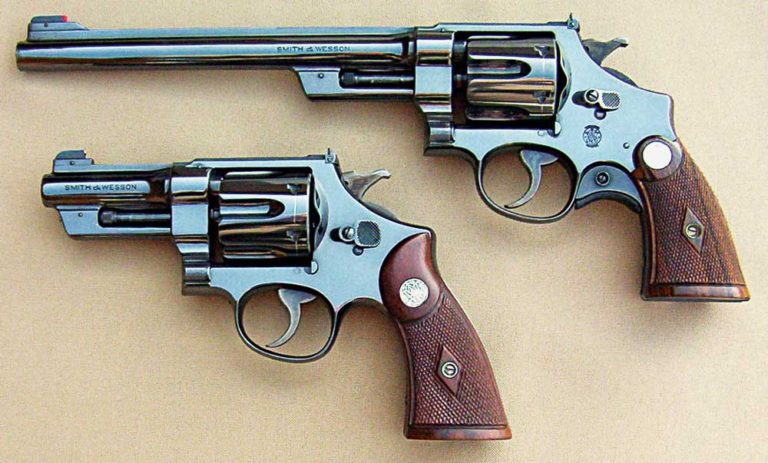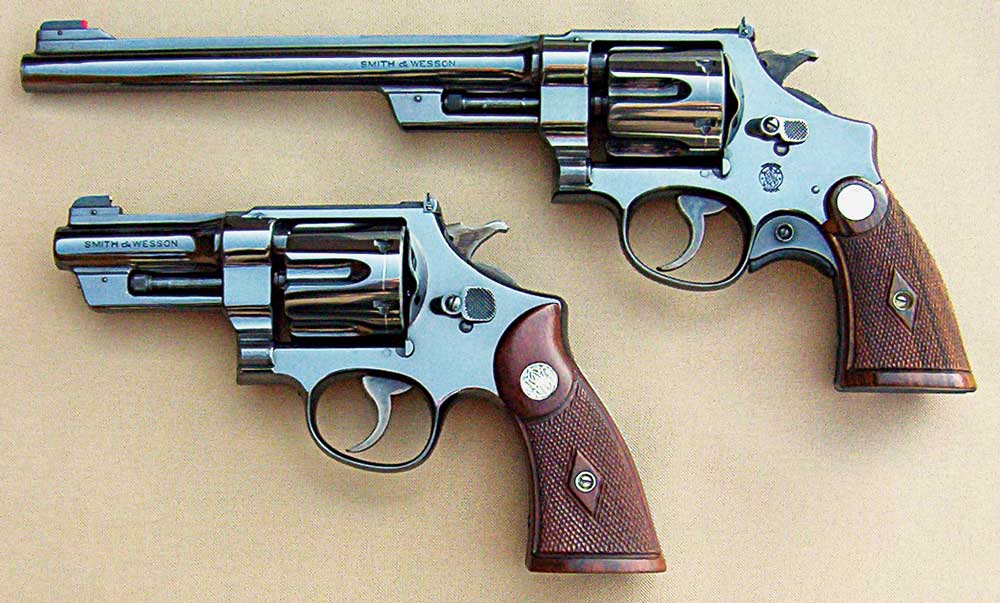

If there is an overall trend, it is that over the course of the past nine years, prices of the majority of Smith & Wesson firearms have increased steadily but modestly, with most models maybe averaging a 10- to 50-percent increase over that time span.
A few have more or less stayed the same, and a small number have actually shown slight decreases in values. There are, of course, stellar exceptions, and many of these are guns were predicted in the previous edition to continue to increase in value ahead of the pack. Here are the authors' opinion on what they've seen in S&W current value trends.
Post-War — There is significant collector interest, and attendant value increase, in the variations of the Hand Ejector revolvers following the end of WWII, up through the introduction of model numbering in 1957. This marked an era when factory production was changing from military production to address the pent-up demand for civilian firearms, and when a number of changes were being made to the designs of the classic Hand Ejectors. There are lots of tasty variations as old parts are used up and mixed with new production. Collectors get all goo-goo eyed for stuff like “Improved Models” and “Transitional Models” and “Pre-Models.”
Early numbered models — There is also a significant interest in the early numbered model revolvers, from 1957 through about the early 1980s.
Classic N-frame revolvers — For the past twenty years, these have been the glamour guns of S&W collecting, and they show no indication of slowing down. The leaders of this particular pack have always been the Triple-Locks, Registered Magnums, and early .44 Magnums.
Dash Ones — Collecting Numbered Model Hand Ejectors by the dash variation has become a thing. And these collectors have noticed that among the carbon steel N and K frames, the “-1” variation often saw extremely limited production. This applies only to some of the models where the -1 variation was introduced around 1959 or 1960. The dash one designation indicated a very minor change – the extractor rod went from right hand thread to left hand thread. However, it was only a year or two before another design change occurred and the models were marked as dash two (-2) variations, meaning that a Mod. 29-1 or Mod. 19-1 will be considerably more rare than a Mod. 29-2 or Mod. 19-2. This means that collectors want ‘em.
Rare guns in the best condition — Extremely rare variations tend to be increasing in value a bit faster than common guns. The more popular the general type of gun, the more demand there is for rare variations of that type. I.e., .357 N-frame rarities bring a much greater premium than rare variations of the .35 auto. And, of course, higher condition rare guns increase even faster.
Best condition old guns — Even where the general value of an antique model may have been somewhat stagnant or even decreased over the past few years, the best condition examples tend to increase faster than the average specimens. The dollar spread between the finest condition and average condition is increasing.
Used shootable guns have value — Guns that are common, worn, obsolete, refinished, modified, and ugly will still have value if they are in shootable condition. Police trade-in pistols and revolvers that have lots of holster wear will bring $200 to $400 if they are shooters.
This article is an excerpt from the Standard Catalog of Smith & Wesson, 4th Edition.

Next Step: Get your FREE Printable Target Pack
Enhance your shooting precision with our 62 MOA Targets, perfect for rifles and handguns. Crafted in collaboration with Storm Tactical for accuracy and versatility.
Subscribe to the Gun Digest email newsletter and get your downloadable target pack sent straight to your inbox. Stay updated with the latest firearms info in the industry.

![Best Concealed Carry Guns In 2025 [Field Tested] Wilson Combat EDC X9S 1](https://gundigest.com/wp-content/uploads/Wilson-Combat-EDC-X9S-1-324x160.jpg)


![Best 9mm Carbine: Affordable PCCs [Tested] Ruger Carbine Shooting](https://gundigest.com/wp-content/uploads/Ruger-Carbine-Shooting-100x70.jpg)
![Best AR-15: Top Options Available Today [Field Tested] Harrington and Richardson PSA XM177E2 feature](https://gundigest.com/wp-content/uploads/Harrington-and-Richardson-PSA-XM177E2-feature-100x70.jpg)
